traction control VOLVO V60 CROSS COUNTRY 2018 Owner´s Manual
[x] Cancel search | Manufacturer: VOLVO, Model Year: 2018, Model line: V60 CROSS COUNTRY, Model: VOLVO V60 CROSS COUNTRY 2018Pages: 404, PDF Size: 9.6 MB
Page 5 of 404
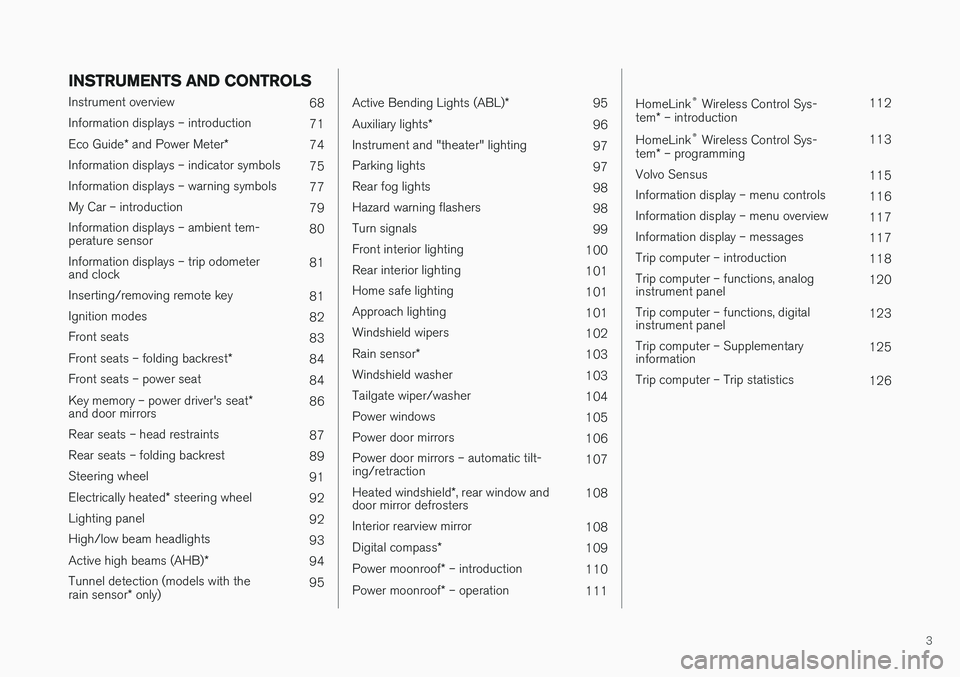
3
INSTRUMENTS AND CONTROLS
Instrument overview 68
Information displays – introduction 71
Eco Guide * and Power Meter *
74
Information displays – indicator symbols 75
Information displays – warning symbols 77
My Car – introduction 79
Information displays – ambient tem- perature sensor 80
Information displays – trip odometerand clock 81
Inserting/removing remote key 81
Ignition modes 82
Front seats 83
Front seats – folding backrest *
84
Front seats – power seat 84
Key memory – power driver's seat *
and door mirrors 86
Rear seats – head restraints 87
Rear seats – folding backrest 89
Steering wheel 91
Electrically heated * steering wheel
92
Lighting panel 92
High/low beam headlights 93
Active high beams (AHB) *
94
Tunnel detection (models with the rain sensor * only) 95
Active Bending Lights (ABL)
*
95
Auxiliary lights *
96
Instrument and "theater" lighting 97
Parking lights 97
Rear fog lights 98
Hazard warning flashers 98
Turn signals 99
Front interior lighting 100
Rear interior lighting 101
Home safe lighting 101
Approach lighting 101
Windshield wipers 102
Rain sensor *
103
Windshield washer 103
Tailgate wiper/washer 104
Power windows 105
Power door mirrors 106
Power door mirrors – automatic tilt- ing/retraction 107
Heated windshield *, rear window and
door mirror defrosters 108
Interior rearview mirror 108
Digital compass *
109
Power moonroof * – introduction
110
Power moonroof * – operation
111
HomeLink®
Wireless Control Sys-
tem * – introduction 112
HomeLink ®
Wireless Control Sys-
tem * – programming 113
Volvo Sensus 115
Information display – menu controls 116
Information display – menu overview 117
Information display – messages 117
Trip computer – introduction 118
Trip computer – functions, analog instrument panel 120
Trip computer – functions, digitalinstrument panel 123
Trip computer – Supplementaryinformation 125
Trip computer – Trip statistics 126
Page 26 of 404
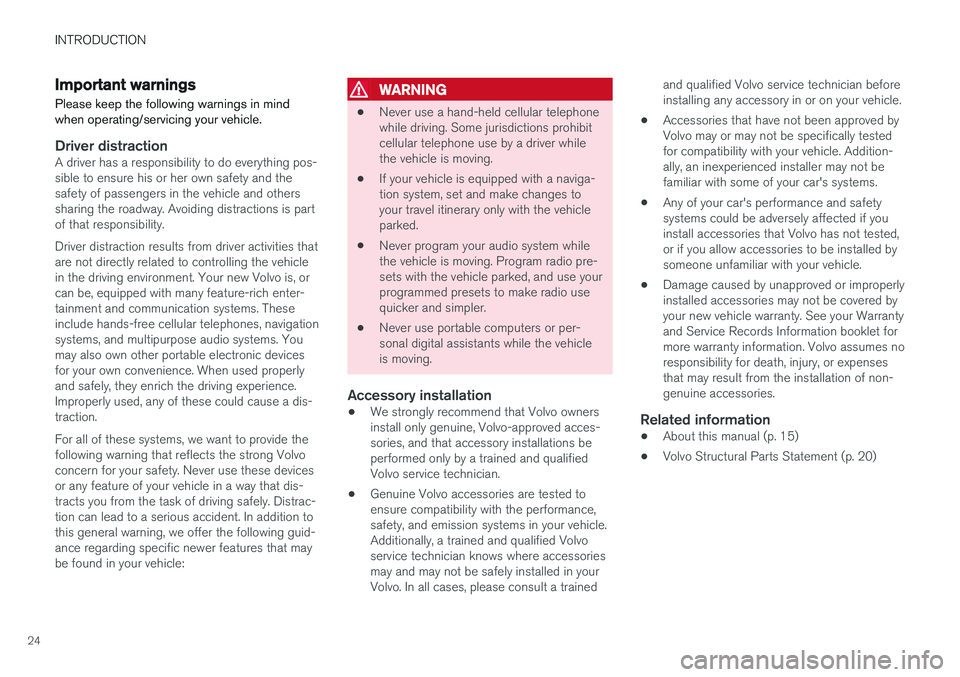
INTRODUCTION
24
Important warnings
Please keep the following warnings in mind when operating/servicing your vehicle.
Driver distractionA driver has a responsibility to do everything pos- sible to ensure his or her own safety and thesafety of passengers in the vehicle and otherssharing the roadway. Avoiding distractions is partof that responsibility. Driver distraction results from driver activities that are not directly related to controlling the vehiclein the driving environment. Your new Volvo is, orcan be, equipped with many feature-rich enter-tainment and communication systems. Theseinclude hands-free cellular telephones, navigationsystems, and multipurpose audio systems. Youmay also own other portable electronic devicesfor your own convenience. When used properlyand safely, they enrich the driving experience.Improperly used, any of these could cause a dis-traction. For all of these systems, we want to provide the following warning that reflects the strong Volvoconcern for your safety. Never use these devicesor any feature of your vehicle in a way that dis-tracts you from the task of driving safely. Distrac-tion can lead to a serious accident. In addition tothis general warning, we offer the following guid-ance regarding specific newer features that maybe found in your vehicle:
WARNING
• Never use a hand-held cellular telephone while driving. Some jurisdictions prohibitcellular telephone use by a driver whilethe vehicle is moving.
• If your vehicle is equipped with a naviga-tion system, set and make changes toyour travel itinerary only with the vehicleparked.
• Never program your audio system whilethe vehicle is moving. Program radio pre-sets with the vehicle parked, and use yourprogrammed presets to make radio usequicker and simpler.
• Never use portable computers or per-sonal digital assistants while the vehicleis moving.
Accessory installation
•We strongly recommend that Volvo ownersinstall only genuine, Volvo-approved acces-sories, and that accessory installations beperformed only by a trained and qualifiedVolvo service technician.
• Genuine Volvo accessories are tested toensure compatibility with the performance,safety, and emission systems in your vehicle.Additionally, a trained and qualified Volvoservice technician knows where accessoriesmay and may not be safely installed in yourVolvo. In all cases, please consult a trained and qualified Volvo service technician beforeinstalling any accessory in or on your vehicle.
• Accessories that have not been approved byVolvo may or may not be specifically testedfor compatibility with your vehicle. Addition-ally, an inexperienced installer may not befamiliar with some of your car's systems.
• Any of your car's performance and safetysystems could be adversely affected if youinstall accessories that Volvo has not tested,or if you allow accessories to be installed bysomeone unfamiliar with your vehicle.
• Damage caused by unapproved or improperlyinstalled accessories may not be covered byyour new vehicle warranty. See your Warrantyand Service Records Information booklet formore warranty information. Volvo assumes noresponsibility for death, injury, or expensesthat may result from the installation of non-genuine accessories.Related information
•
About this manual (p. 15)
• Volvo Structural Parts Statement (p. 20)
Page 109 of 404
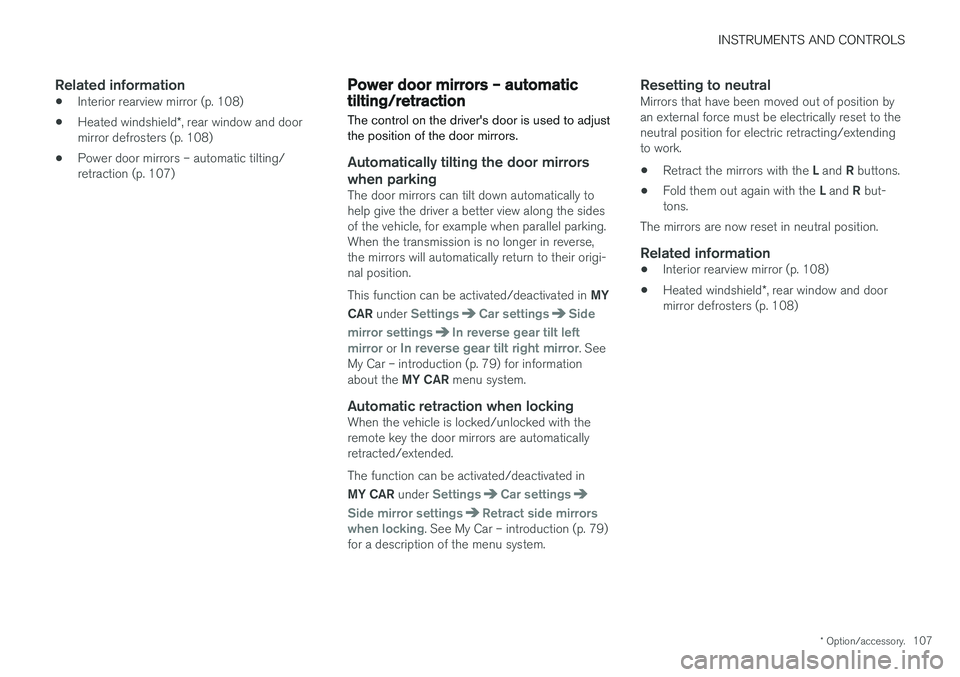
INSTRUMENTS AND CONTROLS
* Option/accessory.107
Related information
•Interior rearview mirror (p. 108)
• Heated windshield
*, rear window and door
mirror defrosters (p. 108)
• Power door mirrors – automatic tilting/ retraction (p. 107)
Power door mirrors – automatic tilting/retraction
The control on the driver's door is used to adjust the position of the door mirrors.
Automatically tilting the door mirrors
when parking
The door mirrors can tilt down automatically to help give the driver a better view along the sidesof the vehicle, for example when parallel parking.When the transmission is no longer in reverse,the mirrors will automatically return to their origi-nal position. This function can be activated/deactivated in MY
CAR under
SettingsCar settingsSide
mirror settings
In reverse gear tilt left
mirror or In reverse gear tilt right mirror. See
My Car – introduction (p. 79) for information about the MY CAR menu system.
Automatic retraction when lockingWhen the vehicle is locked/unlocked with the remote key the door mirrors are automaticallyretracted/extended. The function can be activated/deactivated in MY CAR under
SettingsCar settings
Side mirror settingsRetract side mirrors
when locking. See My Car – introduction (p. 79)
for a description of the menu system.
Resetting to neutralMirrors that have been moved out of position by an external force must be electrically reset to theneutral position for electric retracting/extendingto work. • Retract the mirrors with the
L and R buttons.
• Fold them out again with the
L and R but-
tons.
The mirrors are now reset in neutral position.
Related information
• Interior rearview mirror (p. 108)
• Heated windshield
*, rear window and door
mirror defrosters (p. 108)
Page 176 of 404
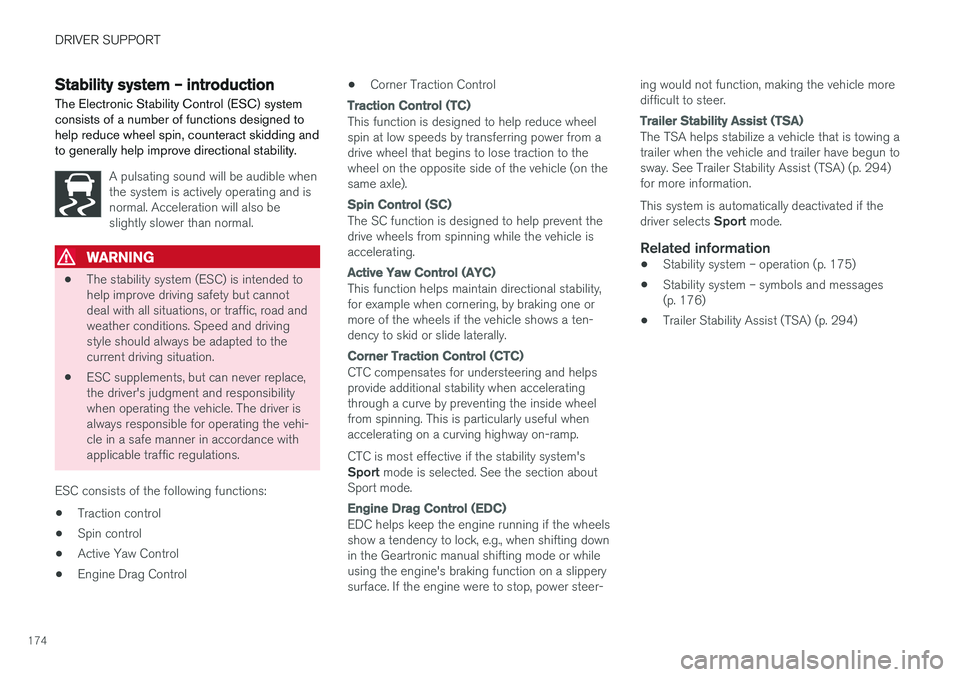
DRIVER SUPPORT
174
Stability system – introduction The Electronic Stability Control (ESC) system consists of a number of functions designed tohelp reduce wheel spin, counteract skidding andto generally help improve directional stability.
A pulsating sound will be audible when the system is actively operating and isnormal. Acceleration will also beslightly slower than normal.
WARNING
•The stability system (ESC) is intended to help improve driving safety but cannotdeal with all situations, or traffic, road andweather conditions. Speed and drivingstyle should always be adapted to thecurrent driving situation.
• ESC supplements, but can never replace,the driver's judgment and responsibilitywhen operating the vehicle. The driver isalways responsible for operating the vehi-cle in a safe manner in accordance withapplicable traffic regulations.
ESC consists of the following functions:
• Traction control
• Spin control
• Active Yaw Control
• Engine Drag Control •
Corner Traction Control
Traction Control (TC)
This function is designed to help reduce wheel spin at low speeds by transferring power from adrive wheel that begins to lose traction to thewheel on the opposite side of the vehicle (on thesame axle).
Spin Control (SC)
The SC function is designed to help prevent the drive wheels from spinning while the vehicle isaccelerating.
Active Yaw Control (AYC)
This function helps maintain directional stability, for example when cornering, by braking one ormore of the wheels if the vehicle shows a ten-dency to skid or slide laterally.
Corner Traction Control (CTC)
CTC compensates for understeering and helps provide additional stability when acceleratingthrough a curve by preventing the inside wheelfrom spinning. This is particularly useful whenaccelerating on a curving highway on-ramp. CTC is most effective if the stability system's Sport
mode is selected. See the section about
Sport mode.
Engine Drag Control (EDC)
EDC helps keep the engine running if the wheels show a tendency to lock, e.g., when shifting downin the Geartronic manual shifting mode or whileusing the engine's braking function on a slipperysurface. If the engine were to stop, power steer- ing would not function, making the vehicle moredifficult to steer.
Trailer Stability Assist (TSA)
The TSA helps stabilize a vehicle that is towing a trailer when the vehicle and trailer have begun tosway. See Trailer Stability Assist (TSA) (p. 294)for more information. This system is automatically deactivated if the driver selects
Sport mode.
Related information
•Stability system – operation (p. 175)
• Stability system – symbols and messages (p. 176)
• Trailer Stability Assist (TSA) (p. 294)
Page 192 of 404

||
DRIVER SUPPORT
190In the event of automatic deactivation, an audible signal will sound and the message
Cruise
control Cancelled is shown in the instrument
panel. The driver must then intervene and adapt the vehicle's speed to the surrounding traffic andregulate the distance to the vehicle ahead. An automatic switch to standby mode may be caused if:
• engine speed (rpm) is too high/low
• The driver's door is opened
• The driver unbuckles his/her seat belt
• the vehicle's speed goes below 18 mph(30 km/h)
• the wheels lose traction
• brake temperature is high
• the radar sensor is obstructed by, for exam-ple, wet snow or rain.
Resuming the set speedIf ACC is in standby mode, it can be reactivated by pressing the
button on the steering wheel
keypad. The vehicle will return to the most recently set speed.
WARNING
The vehicle may accelerate quickly after has been pressed if its current speed is con- siderably lower than the set speed.
Turning ACC off completely
Controls and display
Resume previous settings.
Off/On/Standby mode
• From standby mode, press (2)
once.
• From active mode, press (2)
twice.
The set speed and time interval are then cleared from the system's memory and cannot be resumed by pressing (1)
.
Related information
• Adaptive Cruise Control – introduction (p. 183)
Adaptive Cruise Control – passing another vehicle
Passing another vehicleIf your vehicle
Page 277 of 404

STARTING AND DRIVING
}}
275
All Wheel Drive (AWD)Your Volvo can be equipped with permanent All Wheel Drive, which means that power is distrib-uted automatically between the front and rearwheels.
Under normal driving conditions, most of the engine's power is directed to the front wheels.However, if there is any tendency for the frontwheels to spin, an electronically controlled cou-pling distributes power to the wheels that havethe best traction.
NOTE
The message AWD disabled Service
required will be appear in the information
display if an electrical fault should occur in the AWD system. A warning light will also illu-minate in the instrument panel. If this occurs,have the system checked by a trained andqualified Volvo service technician.
Related information
• Transmission – general information (p. 263)
Hill Descent Control (HDC) 11
–
introduction
HDC is a type of automatic engine brake and makes it possible to increase or decrease thevehicle's speed on downhill gradients using onlythe accelerator pedal, without applying thebrakes. The brake system functions automaticallyto maintain a low and steady speed.
IntroductionNormally, when the accelerator pedal is released while driving down hills, the vehicle's speed slowsas the engine runs at lower rpm (the normalengine braking effect). However, if the downhillgradient becomes steeper and if the vehicle iscarrying a load, speed increases despite theengine braking effect. In this situation, the brakesmust be applied to reduce the vehicle's speed. HDC is particularly useful when driving down steep hills with rough surfaces, and where theroad may have slippery patches.
WARNING
HDC does not function in all situations, and is a supplementary braking aid. The driver hasfull responsibility for driving in a safe manner.
11 Available on the V60 Cross Country in combination with certain engines only.
Page 316 of 404
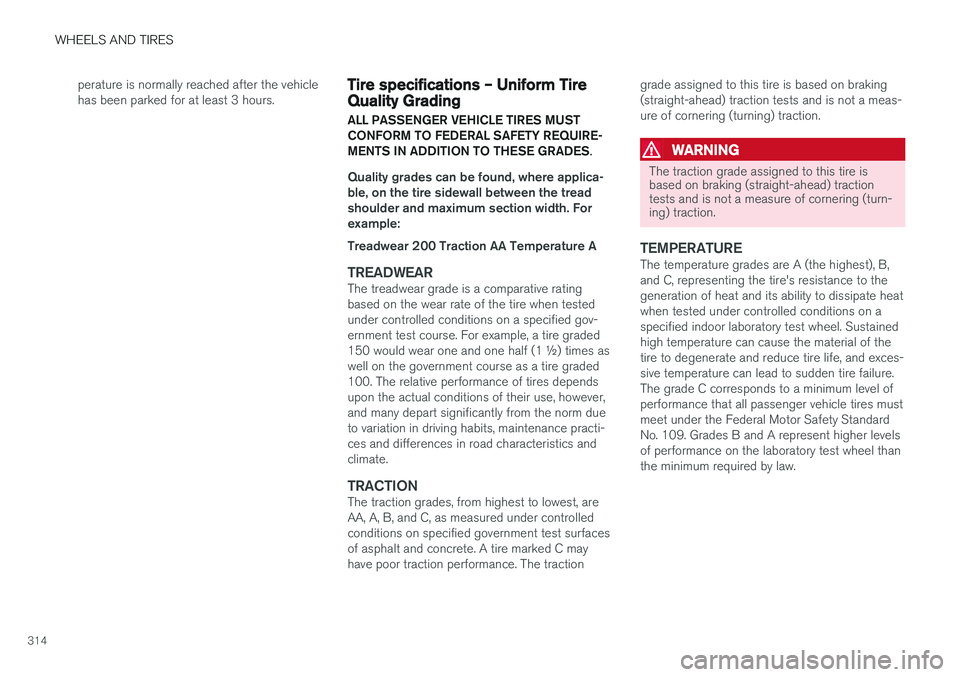
WHEELS AND TIRES
314perature is normally reached after the vehicle has been parked for at least 3 hours.
Tire specifications – Uniform Tire Quality Grading ALL PASSENGER VEHICLE TIRES MUST CONFORM TO FEDERAL SAFETY REQUIRE-MENTS IN ADDITION TO THESE GRADES
.
Quality grades can be found, where applica- ble, on the tire sidewall between the treadshoulder and maximum section width. Forexample: Treadwear 200 Traction AA Temperature A
TREADWEARThe treadwear grade is a comparative rating based on the wear rate of the tire when testedunder controlled conditions on a specified gov-ernment test course. For example, a tire graded150 would wear one and one half (1 ½) times aswell on the government course as a tire graded100. The relative performance of tires dependsupon the actual conditions of their use, however,and many depart significantly from the norm dueto variation in driving habits, maintenance practi-ces and differences in road characteristics andclimate.
TRACTIONThe traction grades, from highest to lowest, areAA, A, B, and C, as measured under controlledconditions on specified government test surfacesof asphalt and concrete. A tire marked C mayhave poor traction performance. The traction grade assigned to this tire is based on braking(straight-ahead) traction tests and is not a meas-ure of cornering (turning) traction.
WARNING
The traction grade assigned to this tire is based on braking (straight-ahead) tractiontests and is not a measure of cornering (turn-ing) traction.
TEMPERATUREThe temperature grades are A (the highest), B, and C, representing the tire's resistance to thegeneration of heat and its ability to dissipate heatwhen tested under controlled conditions on aspecified indoor laboratory test wheel. Sustainedhigh temperature can cause the material of thetire to degenerate and reduce tire life, and exces-sive temperature can lead to sudden tire failure.The grade C corresponds to a minimum level ofperformance that all passenger vehicle tires mustmeet under the Federal Motor Safety StandardNo. 109. Grades B and A represent higher levelsof performance on the laboratory test wheel thanthe minimum required by law.
Page 396 of 404
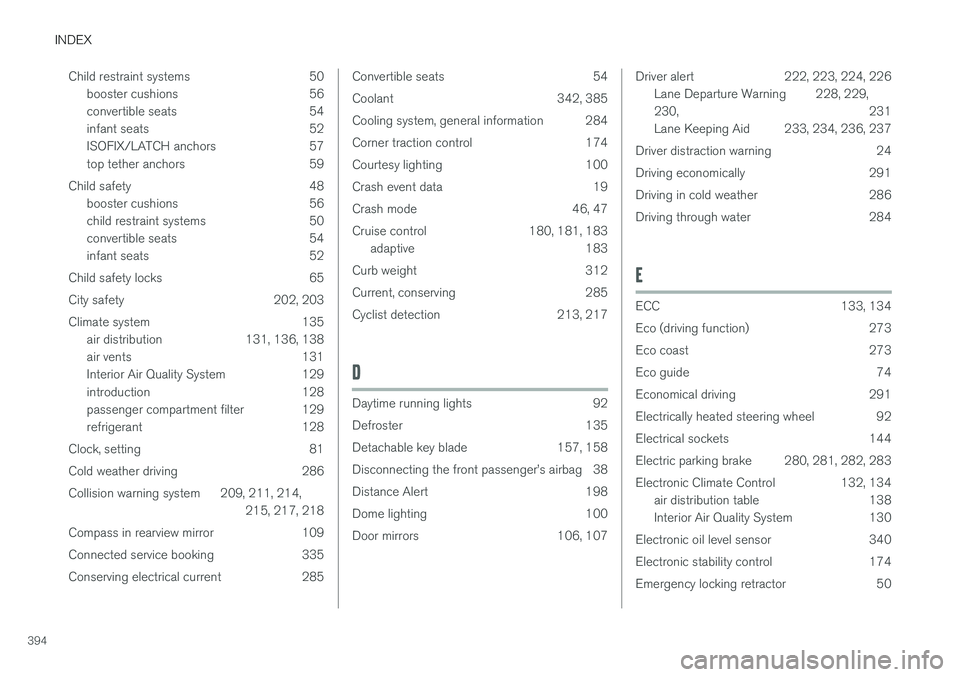
INDEX
394Child restraint systems 50
booster cushions 56
convertible seats 54
infant seats 52
ISOFIX/LATCH anchors 57
top tether anchors 59
Child safety 48 booster cushions 56
child restraint systems 50
convertible seats 54
infant seats 52
Child safety locks 65
City safety 202, 203
Climate system 135 air distribution 131, 136, 138
air vents 131
Interior Air Quality System 129
introduction 128
passenger compartment filter 129
refrigerant 128
Clock, setting 81
Cold weather driving 286
Collision warning system 209, 211, 214, 215, 217, 218
Compass in rearview mirror 109
Connected service booking 335
Conserving electrical current 285
Convertible seats 54
Coolant 342, 385
Cooling system, general information 284
Corner traction control 174
Courtesy lighting 100
Crash event data 19
Crash mode 46, 47
Cruise control 180, 181, 183 adaptive 183
Curb weight 312
Current, conserving 285
Cyclist detection 213, 217
D
Daytime running lights 92
Defroster 135
Detachable key blade 157, 158
Disconnecting the front passenger
Page 400 of 404
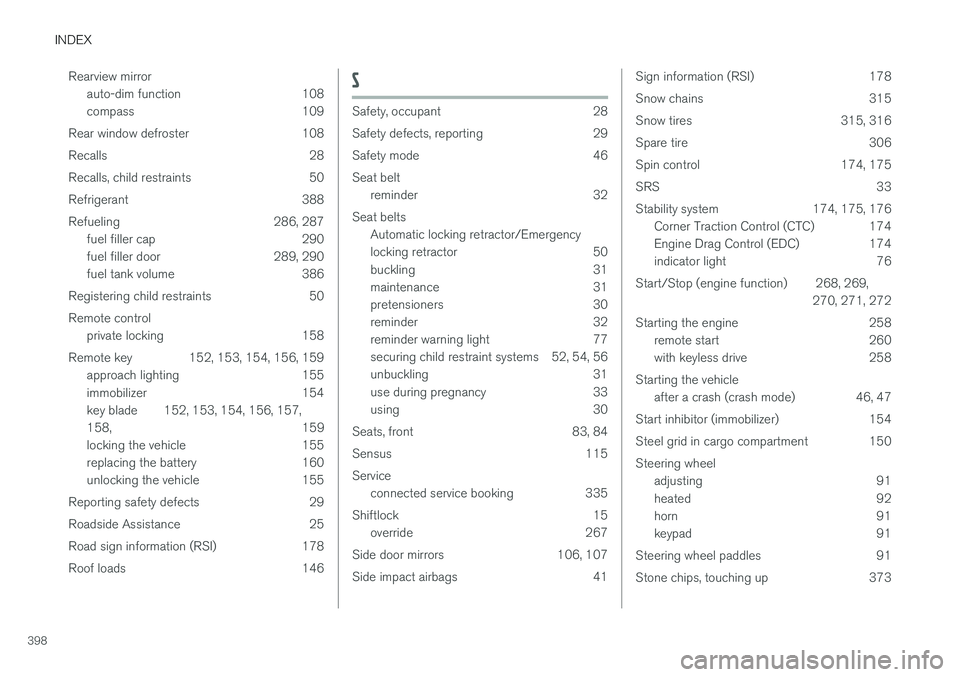
INDEX
398Rearview mirror
auto-dim function 108
compass 109
Rear window defroster 108
Recalls 28
Recalls, child restraints 50
Refrigerant 388
Refueling 286, 287 fuel filler cap 290
fuel filler door 289, 290
fuel tank volume 386
Registering child restraints 50 Remote control private locking 158
Remote key 152, 153, 154, 156, 159 approach lighting 155
immobilizer 154
key blade 152, 153, 154, 156, 157,158 , 159
locking the vehicle 155
replacing the battery 160
unlocking the vehicle 155
Reporting safety defects 29
Roadside Assistance 25
Road sign information (RSI) 178
Roof loads 146
S
Safety, occupant 28
Safety defects, reporting 29
Safety mode 46Seat belt reminder 32
Seat belts Automatic locking retractor/Emergency
locking retractor 50
buckling 31
maintenance 31
pretensioners 30
reminder 32
reminder warning light 77
securing child restraint systems 52, 54, 56
unbuckling 31
use during pregnancy 33
using 30
Seats, front 83, 84
Sensus 115Service connected service booking 335
Shiftlock 15 override 267
Side door mirrors 106, 107
Side impact airbags 41
Sign information (RSI) 178
Snow chains 315
Snow tires 315, 316
Spare tire 306
Spin control 174, 175SRS 33
Stability system 174, 175, 176 Corner Traction Control (CTC) 174
Engine Drag Control (EDC) 174
indicator light 76
Start/Stop (engine function) 268, 269, 270, 271, 272
Starting the engine 258 remote start 260
with keyless drive 258
Starting the vehicle after a crash (crash mode) 46, 47
Start inhibitor (immobilizer) 154
Steel grid in cargo compartment 150Steering wheel adjusting 91
heated 92
horn 91
keypad 91
Steering wheel paddles 91
Stone chips, touching up 373
Page 401 of 404

INDEX
399
Storage spaces 142
Studded tires 315, 316
Sunroof (moonroof) 110, 111
Sun shade 105
Supplemental restraint system 33
warning light 77
Symbols, overview 388
T
Tailgate locking/unlocking 168
opening manually 169
wiper/washer 104
Tailgate wipers 353 Temperature sensor ambient 80
Temporary spare tire 306
Three-way catalytic converter 290
Tire designations 310
Tire inflation pressure 387
Tire Monitor 317, 318, 319
Tire Pressure Monitoring System 320, 323 indicator light 76
Tires 300 age 301
changing from summer to winter 303
glossary of terms 313
improving economy 302
inflation pressure 308, 309
inflation pressure table 387
rotation 300
snow 315, 316
spare 306
specifications 310
speed ratings 310
storing 301
studded 315, 316
tire pressure monitoring system 320
tire sealing system 324
tread wear indicator 302
uniform tire quality grading 314
Tire sealing system 324 Top tether anchors (child restraint sys- tems) 59
Touching up paint 373
Towing a trailer 292, 294
Towing the vehicle 295, 296
Traction control 174, 175
Trailer towing 292, 294Transmission general description 263, 265
Hill Start Assist 263oil 385
shiftlock override 267
Tread wear indicator 302
Trip computer 118
Trip odometers 81
Trips, long distance 285
Tunnel detection 95
Turn signals 99 changing bulbs 348
indicator lights 76
Two-stage booster cushion 60, 62, 64
U
Uniform Tire Quality Grading 314
Unlocking the tailgate 168
Unlocking the vehicle 155, 165, 166, 168
V
Vanity mirror 145 changing bulbs 350
Vehicle Event Data 19
Vehicle information 21